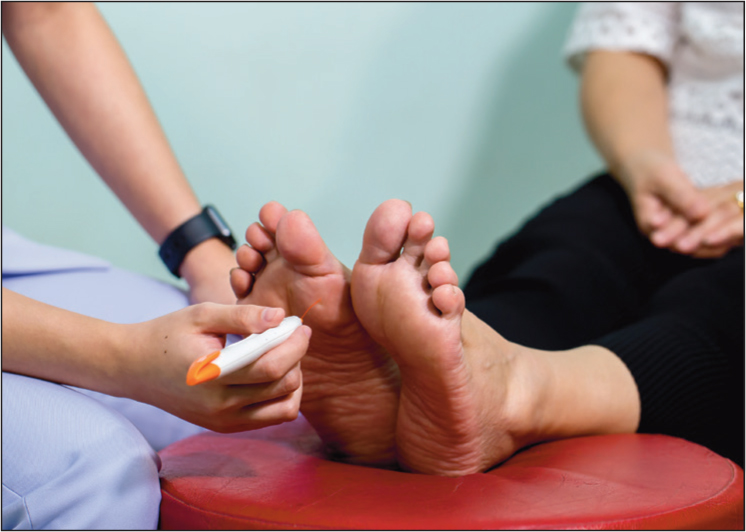Diabetes-related foot disease may be under-reported globally

Globally, diabetes-related foot disease (DFD) is the leading cause of the diabetes disability burden, with some 20 million people worldwide estimated to have DFD, and another 130 million people having a key risk factor for DFD, resulting in around 9 million hospital admissions and 2 million amputations annually.
In this narrative review of 71 publications, Lazzarini et al (2022) analysed the published incidence of hospital admissions for DFD conditions (ulceration, infection, peripheral artery disease, neuropathy) and diabetes-related amputations (minor and major) in nationally representative populations.
The authors’ results suggest that national hospital admission rates are substantially higher for DFD than for amputation alone, and although trends in admission rates for major amputations are decreasing, trends for minor amputations are inconsistent, falling in some countries but rising in others. Trends in admission rates for DFD conditions are also inconsistent and reported in fewer publications than for amputations.
This review's findings suggest that while admission rates for all DFD conditions are higher than those for amputations alone, the more common practice of reporting admission rates only for amputations may substantially underestimate the burden of DFD: ‘While major amputation rates appear to be largely decreasing, this is not the case for hospital admissions for DFD conditions or minor amputation in many populations.’
Sports flooring may reduce fall injuries in residential care
Gustavsson et al (2022) note that it is common for older adults in residential care to have multiple fall risk factors, and that the risk of injury during a fall depends on circumstances like the type of fall, vulnerability like bone strength, and the energy-absorbing characteristics of the contact surface.
The challenge of preventing falls and fall-related injuries among older adults in residential care has prompted evaluations of novel shock-absorbing flooring. However, Gustavsson et al (2022) cite a recent randomised controlled trial that found no significant reductions in injury rates. In this non-randomised Norwegian study undertaken at five residential care units accommodating 193 individuals, Gustavsson et al (2022) evaluated the effect of installing cheaper sports flooring (8.3 mm thick) as an alternative in the bedrooms of one of the five units. The intervention unit had six wards and 72 single-room apartments.
Over a 46-month period there were 323 falls on sports flooring and 414 falls on regular flooring, with 13% fewer injurious fall rates on sports flooring ‘and the injury risk per fall was lower in fall events that occurred on sports floors.’ The authors conclude that current evidence suggests that sports flooring could be considered for installation in residential care, and that confirmatory randomised trials and updated cost-effectiveness analyses are warranted.
Almost 40% of cancer survivors report pain after completing curative treatment
Some 19.3 million new cases of cancer and 10 million cancer-related deaths were recorded worldwide in 2020, yet mortality rates have generally declined since the 1990s, resulting in more cancer survivors. However, explain Haenen et al (2023), cancer-related pain is often reported by cancer survivors, with one study reporting that 39.3% of all cancer survivors experience pain after finishing curative cancer treatment.
In their meta-analysis of 38 studies, Haenen et al (2023) summarise pain prevalence rates for survivors of different solid cancer types who completed curative treatment. The authors found that 47% of cancer survivors experience pain after finishing their cancer treatment, with pain present in 49% of breast cancer survivors, in 39% of lung cancer survivors and in 55% of gynaecological cancer survivors (although only three studies on gynaecological cancer were evaluated in the authors’ review).
A lack of studies meant that the authors were unable to report meaningfully on the presence of pain for the survivors of rectal and prostate cancers. Further, the authors were unable to make conclusions on the influence of cancer type, treatment strategy, pain measurement or follow-up time on their reported pain prevalence rates. More research is needed to evaluate pain prevalence rates, the presence of different pain mechanisms and pain severities, not only in breast cancer but also in other types of cancer.
Targeting inhaler prescribing could reduce carbon footprint of healthcare in Ireland

Ireland has the fourth highest prevalence of asthma worldwide, with inhalers commonly prescribed therapeutics for respiratory disease. This is cited by Owens et al (2022) who explain that metered dose inhalers (MDIs) contain hydrofluorocarbon greenhouse gases which exert a disproportionate effect on healthcare's carbon footprint. By contrast, since soft mist inhalers and dry powder inhalers (DPIs) do not contain hydrofluorocarbons, they have a fraction of the carbon footprint of MDIs.
In this study, Owens et al (2022) aimed to use Health Market Research data to determine the estimated carbon footprint of all inhalers dispensed in Irish healthcare in 2019. Their analysis showed that in 2019 almost 60% of inhalers dispensed in Ireland were MDIs, with over half of these comprising short-acting beta-agonist (SABA) large volume devices, ‘and this type of inhaler contributed to over 60% to the total carbon footprint of all MDIs.’ However, the carbon footprint of small volume SABA devices was considerably less at only 9% of the total carbon footprint of all MDIs, despite accounting for 18% of all MDIs dispensed.
Targeting inhaler prescribing could potentially improve the carbon footprint of Irish healthcare, with the authors suggesting that ‘establishing the current carbon footprint of the inhalers that are prescribed, dispensed, and disposed in Ireland is a necessary baseline to inform moving towards a net zero health service.’


